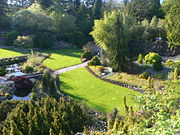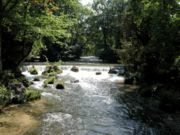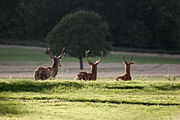Park
2008/9 Schools Wikipedia Selection. Related subjects: Recreation
A park is a bounded area of land, usually in its natural or semi-natural (landscaped) state and set aside for some purpose, usually to do with recreation.
History
The first parks were deer parks, land set aside for hunting by the aristocracy in medieval times. They would have walls or thick hedges around them to keep game in and other people out.
These game preserves evolved into the landscaped parks set around aristocratic houses from the sixteenth century onwards. These may have served as hunting grounds but they also proclaimed the owner's wealth and status. An aesthetic of landscape design began in these parks where the natural landscape was enhanced by landscape architects such as Capability Brown. As cities became crowded, the private hunting grounds became places for the public.
With the Industrial revolution parks took on a new meaning as areas set aside to preserve a sense of nature in the large industrial cities. Sporting activity came to be a major use for these urban parks. Areas of outstanding natural beauty were also set aside as national parks to prevent their being spoilt by uncontrolled development.
In the twentieth century a number of meanings arose which associated the "designed" landscape of a park with other uses such as business parks, theme parks and parkways.
Government-owned or operated parks
National parks
A national park is a reserve of land, usually, but not always declared and owned by a national government, protected from most human development and pollution. National parks are a protected area of IUCN category II. The largest national park in the world is the Northeast Greenland National Park, which was established in 1974.
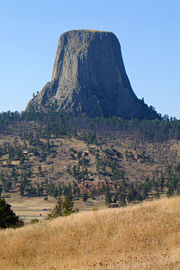
In the United States the concept of preserving unique landscapes for the pleasure of the people of the entire nation was established on June 30, 1864, when President Abraham Lincoln signed the bill creating the Yosemite Grant. A policy of preservation, rather than co-usage as in the National Forests, where grazing, farming and logging are licensed, was implemented four decades later during the presidential administration of Teddy Roosevelt, and Yosemite became a national park. Tourism and, later, recreation were the intended purposes of the lands Roosevelt set aside in the system. John Muir was instrumental in this effort. These parks were ultimately termed national parks and today constitute the U.S. National Park Service. Similarly, U.S. state governments have also set aside and continue to set aside lands of various sizes to preserve them for the enjoyment of the public. National and regional parks are found in many other countries, and vary greatly in the sort of management and administration which they enjoy. There are also national parks in many other countries; the usage of the term varies greatly from one country .
Sub-national parks
In Federal systems, many parks are managed by the local levels of government, rather than by the central government. In the United States these are called state parks and in Canada provincial or terriorial parks, except in Quebec where they are known as National Parks (see Quebec nationalism).
Urban parks
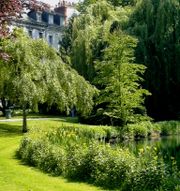
A park is an area of open space provided for recreational use, usually owned and maintained by a local government. Parks commonly resemble savannas or open woodlands, the types of landscape that human beings find most relaxing. Grass is typically kept short to discourage insect pests and to allow for the enjoyment of picnics and sporting activities. Trees are chosen for their beauty and to provide shade.
The world's first public park was Birkenhead Park in the centre of Birkenhead, England opened on 5th April 1847.
Park uses are often divided into two categories: active and passive recreation. Active recreation is that which require intensive development and often involves cooperative or team activity, including playgrounds, ball fields and skateparks. Passive recreation is that which emphasizes the open-space aspect of a park and which involves a low level of development, including picnic areas and trails. Organized football matches take place in parks
Many smaller neighbourhood parks are receiving increased attention and valuation as significant community assets and places of refuge in heavily populated urban areas. Neighbourhood groups around the world are joining together to support local parks that have suffered from urban decay and government neglect.
A linear park is a park that has a much greater length than width. A typical example of a linear park is a section of a former railway that has been converted into a park (i.e. the tracks removed, vegetation allowed to grow back). Parks are sometimes made out of oddly shaped areas of land, much like the vacant lots that often become city neighbourhood parks.
Private parks
Private parks are owned by individuals or businesses and are used at the discretion of the owner. There are a few types of private parks, and some which once were privately maintained and used have now been made open to the public. The concept of the commons is somewhat related to the origin of modern park systems.
Hunting parks originally referred to an area maintained as open space where residences, industry and farming were not allowed, often originally so that nobility might have a place to hunt - see medieval deer park. These were known for instance, as deer parks (deer being originally a term meaning any wild animal). Many country houses in Great Britain and Ireland still have parks of this sort, which since the 18th century have often been carefully landscaped for aesthetic effect. They are usually a mixture of open grassland with scattered trees and sections of woodland, and are often enclosed by a high wall. The area immediately around the house is the garden. In some cases this will also feature sweeping lawns and scattered trees; the basic difference between a country house's park and its garden is that the park is grazed by animals, but they are excluded from the garden.
In some countries, especially the United Kingdom, the concept of the country park was popular in the 1970s, and many such parks were established with government support during that time. Country parks are often located near to urban populations, and provide recreational facilities typical of the countryside rather than the town.
Other uses
The term park is also used in reference to industrial areas, often termed industrial parks. Some technology research areas are also called research parks. Small environmental areas, often part of urban renewal plans, are called pocket parks. The word park may also be used in community names, such as Oak Park or College Park. Sometimes the active recreational aspect may be expressed in the extreme of naming an amusement park, usually privately owned. A car park is an area of land or a building in which cars are parked. The majority of these uses refer to private parks. An amusement park, or theme park is a generic term for a collection of rides and other entertainment attractions assembled for the purpose of entertaining a fairly large group of people.


